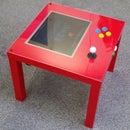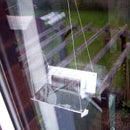Introduction: Retro Gaming Art With Sonic the Hedgehog
It seems like only yesterday since hanging a video game poster on the wall would have confirmed your secret identity as a friendless uber nerd.
But PocketGamer.co.ukhas decided to display its geek chic openlyand proudly, and invites you to do the same. It shows you how to make yourself a delicious - even controversial - conversation piece while saluting the entire video game industry (I am putting two fingers up to the pretentious art world) using an old copy of Sonic the Hedgehog and a cheap, ostentatious picture frame.
Games, it seems, really can be art.
For more top gaming DIY tips like this one, check out PocketGamer.co.uk.
For this instructable, you'll need an old picture frame (this one came from a charity shop), an old video game box (this is an original Sega Mega Drive/Genesis copy of Sonic the Hedgehog), a craft knife, a small screwdriver, some fabric and some masking tape.
Step 1: Dismantle the Frame
You can go out and buy yourself a brand-new frame, if you're feeling particularly flush, but this ostentatious beauty was naught but a couple of quid at the charity shop.
It's not an antique or anything, just a piece of tat ideally suited to this deliberately cheesy project.
Blow the dust off it, and hack out the tacky landscape picture while retaining the backing board. This one was stuck in pretty good, with paper covering the back. One way or another, get the backing board out (the picture was glued to the back in this frame - yours might not be).
Step 2: Cut Mounting Holes Into the Game Box
Here's what we're going to frame - an original Mega Drive game box. It doesn't have to be Sonic The Hedgehog, but it seemed like madness framing anything else.
Mounting a 3D object can be tricky, but if you look inside the box you'll notice two cut-outs in the casing behind the cartridge holder. Perfect for our needs.
Being ultra responsible and careful with your craft knife (PocketGamer.co.ukisn't responsible for your clever knife/flesh tricks), cut two slits on the inner sides of the two cutouts in the back of the game box, going all the way through the inlay card and the plastic cover.
These will be your mounting holes.
Step 3: Add Mounting Holes to the Backing Board
Place the open game box on top of the frame's backing board, ensuring it is nicely centred. Draw through the two slits you cut in the back of the box to mark where you need to cut corresponding mounting holes in the backing board.
The marks are a little difficult to see in this picture, and have been outlined for you.
Unless you've bought yourself an expensive, or antique frame, the backing board will most likely just the cheap hardboard. This might be a bit crap from a carpenter's point of view, but it makes it easy for us to put the mounting holes in the backing board.
You can drill it if you like, but I simply braddled ('awled', if you're American) the mounting holes using a small, flat bladed screwdriver, then cleaned up the edges using my craft knife.
It seemed to work okay.
Step 4: Covering the Backing Board With Fabric
Note, at this point I realised with some considerable effort I could tear the tacky landscape print off the backing board. I wish I'd done this earlier. Never mind.
The next job is covering the backing board with fabric. If you like, you could use a new backing board, cover the old one in wallpaper, or anything else that would look nice behind the Sonic box.
Place the backing board on the fabric (or paper, whatever), draw around it and cut the material to the same size as the board. Cut out your backing material, then mark the mounting holes through the backing board as we did previously.
Fold your backing material in half, and assuming you're mounting holes are nicely centred snip the material to cut out the two slots.
Step 5: Optional Backing Board Padding
This step is optional, but since I'm using a piece of old blue velvet for the backing material, I thought it'd look quite nice. And I was right.
I cut out a piece of thin wadding, exactly the same size as a piece of backing material, complete with slits for the mounting holes.
As I say, this is optional. You could just stick to the backing material directly to the backing board.
Step 6: Attaching the Fabric to the Backing Board
Stick the backing material (with wadding underneath it, if required) to the backing board using masking tape.
Make sure your masking tape won't be visible when the backing board is in the frame.
The masking tape is only really needed to hold the material of the board until the frame is fully reassembled, at which point the game box and the frame itself will hold it in place.
Step 7: Fixing the Game Box to the Backing Board
Thread some ribbon or tape through the mounting holes in the game box, with the loose ends sticking out the back. The loose ends of the ribbon sticking out of the back of the box now need feeding through the front of the backing board.
I used a 'bodkin' to feed the ribbon through the backing material, wadding and backing board.
Pull the two ends of the ribbon tight to secure the game box against the front of the backing board, and then tie them together.
It doesn't hurt to put a couple of pieces of masking tape over the tied ends of the ribbon.
Step 8: Reassemble the Frame
Fit the backing board into the frame. Tape the backing board to the frame using masking tape.
Flip it over, and you're done - marvel at your stylish, geek chic art.
Step 9: Marvel at Your Retro Gaming Art
And to think, some fools spend hundreds, if not thousands of pounds on boring portraits, still life's, sculptures and ornaments.
This piece of classic gaming art is all those things and more. Having one of these on your wall makes you awesome.
Check out PocketGamer.co.ukfor more super awesome gaming, mobile, iPhone and computing DIY ideas.












